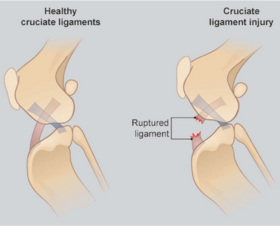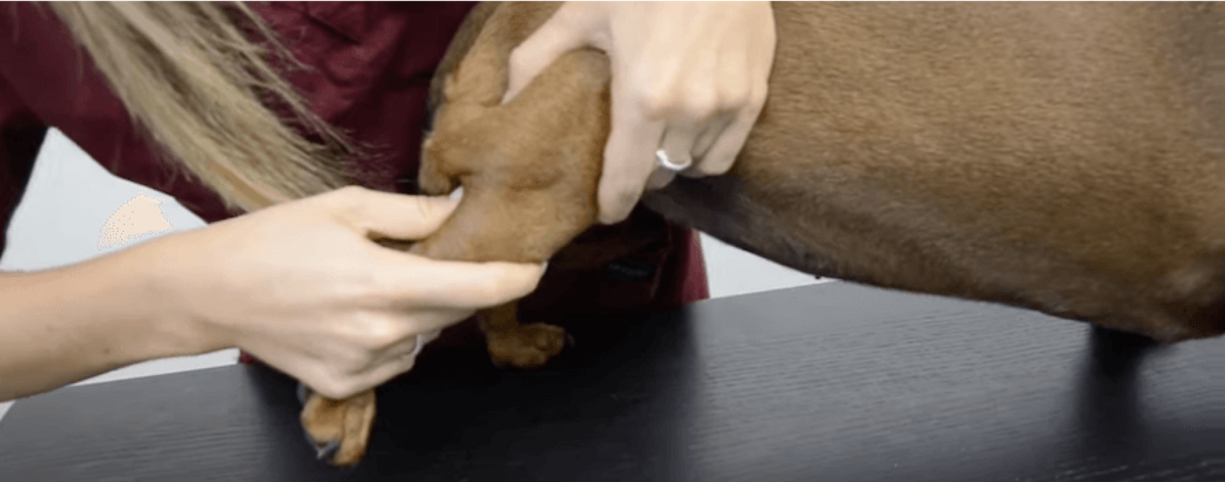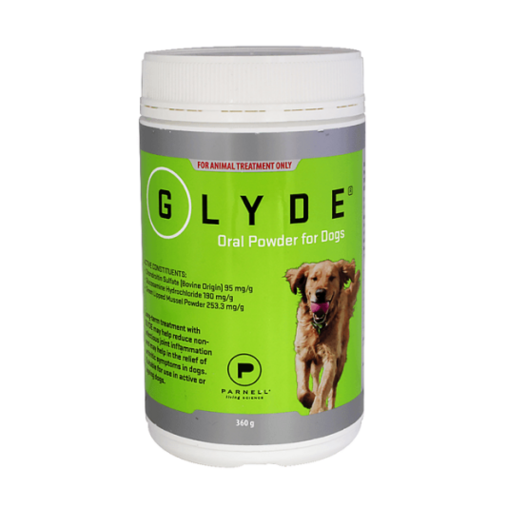Last Updated: 07/05/2025
Cruciate Ligament Injury in Dogs
Has your dog injured their cruciate ligament? Our handy guide will provide you with everything you need to know about cruciate ligament injuries in dogs.
Author: Dr Carla Paszkowski BVSc (Hons)
Reading Time: 43 minutes - long read
A complete guide for diagnosis, treatment, and prevention in dogs
Has your dog injured their cruciate ligament? Or perhaps you are a prospective puppy owner researching your favourite dog breed, but have discovered they are a breed prone to cruciate injuries and want to equip yourself with some knowledge? Our handy guide should provide you with everything you need to know about cruciate ligament injuries in dogs.
What are the cruciate ligaments?
Which dog breeds are prone to cruciate ligament injury?
What are the cruciate ligaments?

Source: PDSA
The canine knee (also known as 'stifle') joint exists between the femur (thigh bone) and tibia (shin bone). There are two ligaments within the stifle joint called the cranial and caudal cruciate ligaments, which are formed in a 'cross' like arrangement relative to each other. These fibrous bands help provide stability in the joint, and resist the effects of weight bearing and twisting movements.
The cranial cruciate ligament (CrCL) in dogs is the same as the 'anterior' cruciate ligament (ACL) in humans. Its specific mechanical function is to prevent the the tibia from shifting forward in front of the femur. It also prevents the knee from rotating or over-extending.
What causes Cruciate ligament injury in dogs?
In humans, trauma to the equivalent ligament (ACL) is common and usually occurs during some form of sporting activity such as skiing or tennis. However, cranial cruciate ligament disease is quite different in dogs: rather than the ligament suddenly breaking due to acute trauma, it usually degrades slowly over time. This is why the treatment options recommended for cruciate ligament injury in dogs are so different from those recommended for humans.
The progressive fraying of the ligament triggers a cascade of events that leads to pain and lameness.
Cruciate injury may be a 'complete' or 'partial' rupture. Partial cruciate ruptures are unlikely to heal and may cause ongoing lameness, and can progress to complete rupture.
There are many risk factors that contribute to a cruciate injury. These include:
- Obesity and being overweight
- Lack of exercise
- Overexertion
- Breed disposition
Is cruciate ligament injury in dogs painful?
Yes. The cruciate ligament itself does not contain nerves, which means that its rupture doesn't cause pain by itself. Instead, the pain is caused by the loss of stability and consequential grinding of cartilage against cartilage. This causes an inflammatory condition known as osteoarthritis, or arthritis. Thus, the painful symptoms of cruciate injury are actually caused by the secondary arthritis (rather than the frayed or ruptured ligament), which means that management of cruciate disease is often aimed at simply treating the arthritis.
DID YOU KNOW Cruciate injury is a degenerative condition in dogs, rather than a traumatic condition - this is why it is often called 'cruciate ligament disease' rather than 'cruciate ligament rupture'.
Dog breeds that are prone to cruciate ligament disease

Some dog breeds seem particularly prone to cruciate ligament injuries. The mechanism behind this isn't totally understood, but could be due to conformational abnormalities (for example Bichon Frise dogs can have tibial anatomy which puts pressure on the ligament).
Signs and Symptoms of Cranial Cruciate Injury
Clinical signs of cranial cruciate ligament injury are usually associated with loss of stability and acute inflammation, and may appear suddenly or develop progressively over time. The most common signs include:

Limping on the hind leg

Stiffness on the hind limb after rest

Reluctance to jump - for example up onto furniture or into the car

Reluctance to exercise for long periods

Thickening and effusion of the stifle joint

Muscle wastage around the knee (if chronic)
Diagnosis of cranial cruciate ligament disease in dogs

How to tell if your dog has cruciate ligament disease
Diagnosis of cruciate ligament injury requires a veterinary examination. Your veterinarian will be able to observe your dog walking, take radiographs (xrays), and test the laxity of the joint via specific manipulation of the knee. Occasionally xrays and physical manipulation of the knee may need to be done under sedation.
Based on the physical exam and radiographs, your vet will be able to determine whether a partial or complete rupture has occurred, and what treatment options is best for your dog's injury.
Treatment of cranial cruciate disease in dogs
There are many ways to treat and manage cruciate injury. Depending on the size of the dog, severity of the condition, the age of the dog, and the lifestyle of the owner, your veterinarian may recommend either surgical or medical (conservative) management.
In either case, weight management is a very important factor for dogs with cruciate disease - no matter their age, severity, or treatment route. All dogs with cruciate disease should aim to be kept very slim. It is the most effective - and least expensive! - method of keeping your dog pain-free.
1. Medical Therapy
Medical management of cruciate disease may be possible in some cases - particularly dogs weighing under 15kg. While very little objective data is available to establish a universal medical approach, subjective data suggests that dogs weighing 15kg or less experience a resolution of lameness from medical management in up to 86% of cases.1 Whereas dogs over 15kg have a less than 20% chance of an acceptable outcome when treated conservatively.2
While it's nice to think that a single 'wonder medication' is effective at controlling pain long-term, in reality a combination of techniques is usually required to be most effective. This multimodal approach should ideally involve a combination of pain relief medication, weight management, cage rest, physiotherapy, environmental changes (like a supportive bed or access ramps) and the use of therapeutic diets or arthritis supplements. These are outlined below:
A. Pain medication
Non-steroidal antiinflammatories (NSAIDs) are the mainstay treatment for pain associated with arthritis and cruciate ligament disease. Common NSAIDs used for osteoarthritis pain include Meloxicam (Metacam), Carprofen (Rimadyl), Dericoxib (Deramaxx), or Firocoxib (Previcox). All of these medications need to be prescribed by your vet.
B. Crate Rest
Crate rest and restricted activity are usually recommended as part of medical management of cruciate disease. This may be required for up to 4 weeks. Crate rest involves keeping your dog in a cage at all times, except when you can carry or assist them outside to toilet. You may exercise your dog with activities such as swimming (see more about this below).
C. Nutritional Supplements and Prescription Diets
The best supplements for cruciate disease are arthritis supplements, because arthritis and cruciate disease are so closely intertwined. Arthritis supplements in dogs most commonly contain one or more of the following nutrients:
- Omega fatty acids. The omega 3 fatty acids DHA and EPA have been demonstrated to have anti inflammatory properties, and as far as supplements for arthritis go, they are backed by the most convincing evidence. Omega 3s can be obtained from lots of difference sources including fish oil, green lipped mussel powder, flaxseeds and nuts. Marine sources of omega fatty acids (such as fish, fish oil and green lipped mussel) are the most effective for dogs.
- Glucosamine and chondroitin. These are the building blocks of normal healthy cartilage and provide essential joint nutrients to help protect, nourish and repair cartilage. Products containing glucosamine and chondroitin are usually harvested from sea mollusks. Despite a lack of strong evidence in the veterinary literature, some veterinarians and owners have found supplementation to be helpful.
View our range of joint care supplements here.
Top supplements for dogs with cruciate ligament disease

Prescription Diets for joint care may also be recommended by your veterinarian. These diets are suitable for dogs over 12 months of age and contain the same beneficial nutrients used in joint supplements, designed to be delivered in a perfect blend. Our top veterinary diets for joint care include Hills Prescription Diet j/d and Royal Canin Mobility CP2+.
D. Environmental Modifications
For a dog with cruciate disease, the physical strain of getting out of bed, climbing stairs, or jumping on and off furniture can be quite challenging and painful. Making changes to your home can really help reduce discomfort for your pet. Our top recommendations include:
1. Ramps and stairs - these are essential for pets who sleep on the furniture, or jump in and out of the car a lot.
2. A raised bed - When looking for a bed, try to find a well-padded bed that is elevated slightly. Rising from ground level can be difficult with stiff joints and an elevated bed requires less movement to stand up. Avoid beds with a large lip as this can be hard to step over.
3. Carpeted, non-slip flooring is also advised around bedding and if possible, in all areas of the house your dog travels to.
4. A heating mat in winter - Cold weather can cause stiff joints, so a heating mat can help soothe sore joints and improve mobility when getting up.
E. Exercise Techniques and Physiotherapy
When it comes to exercising a dog with cruciate disease, non-weightbearing exercise is key. We don't want to overdo it and lead to discomfort and accelerated cartilage destruction, however we do want to achieve a healthy weight which requires some degree of exercise.
Swimming is the ideal option, with minimal pressure placed on the joints. Swimming is a gentle way to strengthen and rebuild muscles to prevent further injury. Many arthritic dogs also respond well to muscle massage and acupuncture.
F. Weight Management
Weight control is the single most important strategy in the management of inflammatory arthritis in dogs. As well as adding extra load to sore joints, fat also releases inflammatory mediators which contribute to inflammation in many part's of your dog's body, including the joints. Read more about how to help your dog maintain a healthy weight.
2. Surgery for Cranial Cruciate Disease
Surgical stabilisation is usually recommended for dogs over 15kg. For cruciate surgery, a specialist veterinary surgeon is usually required. While some veterinarians are qualified and confident in orthopaedic surgeries, many will refer you to a specialist for optimal care.
There are several surgical procedures that can be done for the repair of a ruptured cranial cruciate ligament:
- Intra-Articular Surgical Methods: involve the use of grafts to replace the cranial cruciate ligament. Sometimes these are referred to as a 'Mini-Tightrope System'. This type of surgery is mostly outdated nowadays, as they do not provide reliable long-term stability and can create excessive inflammation.
- Extra-Capsular Suture Technique ('De Angelis Technique'): This procedure involves the placement of a suture or cord outside the joint capsule to provide stability. The hope is that the suture remains in place for 8-12 weeks to allow time for scarring and fibrous tissue to grow, which can help provide stability.3
- Simitri Stable in Stride: This technique involves the positioning of a stifle-stabilising implant (a metal plate with screws) on the medial aspect of the limb. It has not been universally adopted by the orthopaedic community, but initial results are promising.4
- Tibial Plateau Leveling Osteotomy (TPLO): this is a dynamic procedure which uses physics to stabilise the stifle. It involves cutting into the tibia bone, rotating a segment and fixing it in place with a metal plate to reduce the tibial plateau angle. By reducing this angle, the tibia stays is stabilised and secure. The TPLO is one of the more common procedures performed nowadays.
- Tibial Tuberosity Advancement (TTA): A geometry-modifying procedure, which involves cutting the top of the tibia and angling it forward with the use of a metal plate. This alters the angle of the patellar ligament and creates stability.
- Triple Tibial Osteotomy (TTO): A hybrid procedure which involves the removal of a wedge of bone from the tibia, as well as the advancement of the tibial tuberosity. A large plate and screws is needed to hold the repair together.

How Much does Cruciate Ligament Surgery in Australia Cost?
$2000-6000
Want to know more?
After more information about taking care of your dog with arthritis? Check out our video and additional articles below:
Arthritis in dogs: what causes it and how do I know if my dog is affected?
Obesity in pets: why it's a problem and what to do about it
How the right diet can make old dogs young again
Your guide to fleas, ticks and worms
How to help your dog with arthritis
Dr. Carla discusses how to help your dog with arthritis. For more great pet videos from our vets, head over to our Youtube Channel.
References
1. Arnoczky SP, Marshall JL: The cruciate ligaments of the canine stifle: an anatomical and functional analysis. Am J Vet Res 1977 Vol 38 (11) pp. 1807-14.
2. Vasseur PB: Clinical Results Following Nonoperative Management for Rupture of the Cranial Cruciate Ligament in Dogs. Vet Surg 1984 Vol 13 (4) pp. 243-46.
3. Casale SA, McCarthy RJ: Complications associated with lateral fabellotibial suture surgery for cranial cruciate ligament injury in dogs: 363 cases (1997-2005). J Am Vet Med Assoc 2009 Vol 234 (2) pp. 229-35.
4. Barkowski VJ, Embleton NA: Surgical Technique and Initial Clinical Experience with a Novel Extracapsular Articulating Implant for Treatment of the Canine Cruciate Ligament Deficient Stifle Joint. Vet Surg 2016 Vol 45 (6) pp. 804-15.